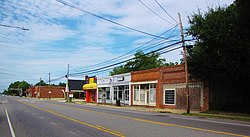Wagram, North Carolina
Wagram, North Carolina | |
|---|---|
 Main Street | |
 Location in Scotland County and the state of North Carolina. | |
| Coordinates: 34°53′20″N 79°21′55″W / 34.88889°N 79.36528°W | |
| Country | United States |
| State | North Carolina |
| County | Scotland |
| Government | |
| • Mayor | Milton Farmer |
| Area | |
| • Total | 1.46 sq mi (3.77 km2) |
| • Land | 1.46 sq mi (3.77 km2) |
| • Water | 0.00 sq mi (0.00 km2) |
| Elevation | 240 ft (70 m) |
| Population (2020) | |
| • Total | 615 |
| • Density | 422.10/sq mi (162.97/km2) |
| Time zone | UTC-5 (Eastern (EST)) |
| • Summer (DST) | UTC-4 (EDT) |
| ZIP code | 28396 |
| Area codes | 910, 472 |
| FIPS code | 37-70480[3] |
| GNIS feature ID | 2406815[2] |
Wagram (/ˈweɪɡrəm/ WAY-grum)[4] is a town in Scotland County, North Carolina, United States. The population was 840 at the 2010 census. The town was named for the Battle of Wagram, a Napoleonic battle at Deutsch-Wagram in Austria.[5]
History
[edit]The community was incorporated as Wagram in 1911.[6] The Richmond Temperance and Literary Society Hall and Shaw Family Farms are listed on the National Register of Historic Places.[7] In 2007 the town erected a community recreation center.[8]
Geography
[edit]According to the United States Census Bureau, the town has a total area of 1.5 square miles (3.9 km2), all of it land.
Demographics
[edit]| Census | Pop. | Note | %± |
|---|---|---|---|
| 1920 | 174 | — | |
| 1930 | 309 | 77.6% | |
| 1940 | 388 | 25.6% | |
| 1950 | 397 | 2.3% | |
| 1960 | 562 | 41.6% | |
| 1970 | 718 | 27.8% | |
| 1980 | 617 | −14.1% | |
| 1990 | 480 | −22.2% | |
| 2000 | 801 | 66.9% | |
| 2010 | 840 | 4.9% | |
| 2020 | 615 | −26.8% | |
| U.S. Decennial Census[9] | |||
As of the census[3] of 2000, there were 801 people, 307 households, and 224 families residing in the town. The population density was 545.8 inhabitants per square mile (210.7/km2). There were 361 housing units at an average density of 246.0 per square mile (95.0/km2). The racial makeup of the town was 45.32% White, 48.06% African American, 4.62% Native American, 0.50% Asian, 0.37% from other races, and 1.12% from two or more races. Hispanic or Latino of any race were 0.62% of the population.
There were 307 households, out of which 28.7% had children under the age of 18 living with them, 49.2% were married couples living together, 20.2% had a female householder with no husband present, and 27.0% were non-families. 23.5% of all households were made up of individuals, and 11.4% had someone living alone who was 65 years of age or older. The average household size was 2.61 and the average family size was 3.09.
In the town, the population was spread out, with 26.8% under the age of 18, 7.2% from 18 to 24, 23.6% from 25 to 44, 27.7% from 45 to 64, and 14.6% who were 65 years of age or older. The median age was 40 years. For every 100 females, there were 82.5 males. For every 100 females age 18 and over, there were 75.4 males.
The median income for a household in the town was $39,583, and the median income for a family was $44,615. Males had a median income of $30,809 versus $19,107 for females. The per capita income for the town was $16,089. About 14.3% of families and 18.7% of the population were below the poverty line, including 24.9% of those under age 18 and 32.6% of those age 65 or over.
Notable people
[edit]- Mary H. Odom, North Carolina state legislator and educator, lived in Wagram.[10]
References
[edit]- ^ "ArcGIS REST Services Directory". United States Census Bureau. Retrieved September 20, 2022.
- ^ a b U.S. Geological Survey Geographic Names Information System: Wagram, North Carolina
- ^ a b "U.S. Census website". United States Census Bureau. Retrieved January 31, 2008.
- ^ "NC Pronunciation Guide". WRAL. Retrieved August 16, 2023.
- ^ Stewart, George R. (1970). American place-names; a concise and selective dictionary for the continental United States of America. New York: Oxford University Press.
- ^ Powell, William S. (1976). The North Carolina Gazetteer: A Dictionary of Tar Heel Places. Chapel Hill: The University of North Carolina Press. p. 513. ISBN 9780807812471.
- ^ "National Register Information System". National Register of Historic Places. National Park Service. July 9, 2010.
- ^ Elder, Renee (August 13, 2021). "Black residents in a small NC town say their community is neglected. What happens now?". Border Belt Independent. Retrieved July 21, 2022.
- ^ "Census of Population and Housing". Census.gov. Retrieved June 4, 2015.
- ^ 'North Carolina Manual 1975,' Thad Eure, North Carolina Secretary of State: 1975, Biographical Sketch of Mary H. Odom, pg. 312

